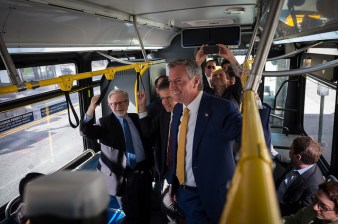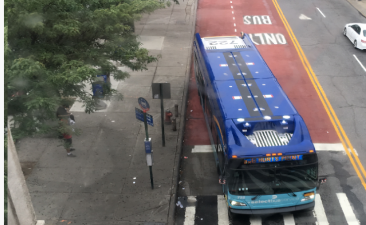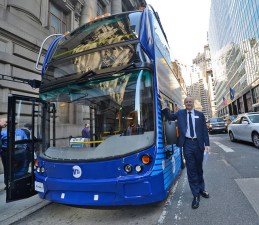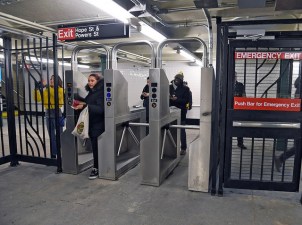To Fix the Bronx Bus Network, Byford Needs More Enforcement

The transportation officials who are in the process of overhauling the entire Bronx bus network warn that simply redrawing colored lines on a map won’t improve service unless the city and state do more to keep cars out of bus lanes.
Even the most perfectly redesigned bus system would be dead on arrival if the streets aren’t kept clear enough to get the two million daily riders citywide, and the nearly 490,000 Bronx riders, where they need to go. The NYPD and Department of Transportation must do more to keep the lanes free of illegally parked cars, but they also need help through automated camera enforcement, said NYC Transit President Andy Byford.
“Our buses can’t levitate, they are stuck in traffic — that has been a major factor,” said Byford during TransitCenter’s panel discussion on the Bronx network redesign on Thursday. “I think buses are great, but they need to be given a fighting chance to get through the streets so we need to have a serious conversation about keeping existing bus lanes free, moving and stopping abuse of bus lanes, get better managed deliveries in those bus lanes. One poorly parked vehicle can hold up the whole route.”
For Bronx bus riders, good service is not just a matter of getting to work, it’s also a matter of basic economic security – being late for a shift can cost you your job, says Stephanie Burgos-Veras of @RidersNY pic.twitter.com/h60tInCVRU
— TransitCenter (@TransitCenter) June 13, 2019
And bus lane cameras are one of the best ways to keep cars out. Byford has said previously that cameras work better than cops. Currently, the state has authorized the city to install cameras on just 16 routes — a tiny fraction of the 252 routes citywide.
A pending bill by Assembly Member Nily Rozic, A6777B, would lift the cap — and increase penalties for repeat offenders. A group of City Council members have invoked a “home rule” request to get the legislature to pass the bill before adjourning at the end of June.
“The City of New York spoke loud and clear: we need to make bus service work, and Albany must allow New York City to enforce existing laws and discourage illegal parking and driving in bus lanes,” said Tri-State Transportation Campaign, the Straphangers Campaign and the Riders Alliance in a joint statement on Friday. “This is how we make it work better: by enforcing the longstanding laws on the books and keeping bus lanes free of cars parking and driving illegally.”

In the Bronx, nearly 60 percent of residents rely on public transit for their daily commutes, and at least 16 percent commute primarily by bus. But the slowest-in-the-nation buses crawl along at what Byford called “embarrassingly” slow speeds — an average of less than seven miles-per-hour, and some times as slow as five miles-per-hour during peak times.
Redesigning the Bronx bus system, which hasn’t been revamped in decades, will help speed things up, but the surest way to get buses moving faster is by making sure no cars are blocking them — and that’s where the cameras come in.
“[We would need] not just simply a modest increase but something transformative — similar to what happened with the speed camera bill,” Nivardo Lopez, the DOT’s Bronx borough commissioner, said during the panel discussion on Thursday night, referring to the state’s increase in speed cameras from 140 to 750 school zones earlier this year. “We need that type of increase for bus lane cameras. That has to be a big part of the conversation.”
Earlier this month, the MTA unveiled a draft plan for the new Bronx bus system, which includes more streamlined routes, better bus stop balancing, improved connections, and more frequency. Stops now are placed at roughly every 800 feet, causing buses to be stopped or idle for a quarter of the time — placing them at least every 1,300 feet will get them moving faster, said Byford.
Byford: 800 feet between stops is far too little. 1,300 feet is more like it.
— TransitCenter (@TransitCenter) June 13, 2019
City and state transportation officials will ask riders who regularly use and rely on the system to offer input about how they’d like to see it improved — but that means making some choices. Straphangers may be asked to choose between more frequent service, or service on just the main arterials that would run as fast as the subway, said Byford.
“We’re starting with a blank sheet of paper and giving them choices. Is frequency the most important thing for you or is coverage, because invariably there are some choices to be made here,” said Byford. “Every route means less frequency, or stick to main arterials but run relentless service like the subway — turn up and go.”
Of course, there’s one problem. Buses are, well, buses. Byford knows his work is cut out for him with his own board.
“I do try to get buses on the transit committee agenda but all everyone wants to talk about is subways,” he said, not really joking.
The MTA will host six more open houses on the Bronx draft plan between June 17 and June 27.





